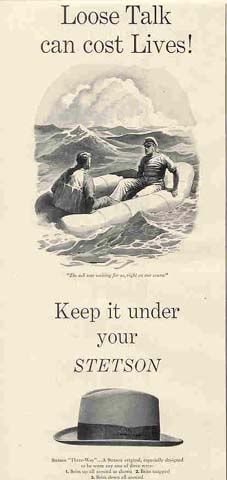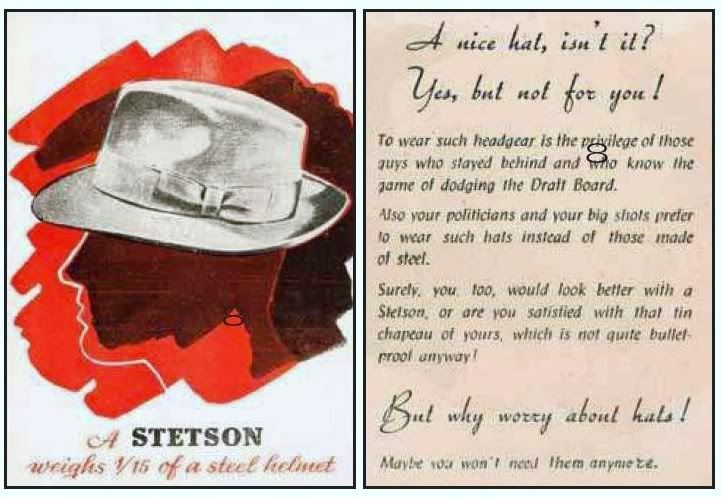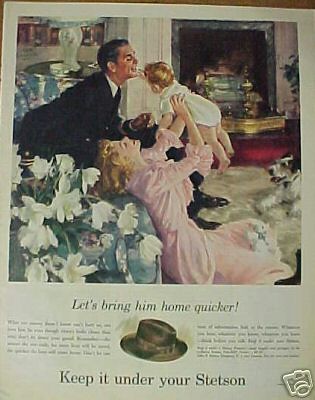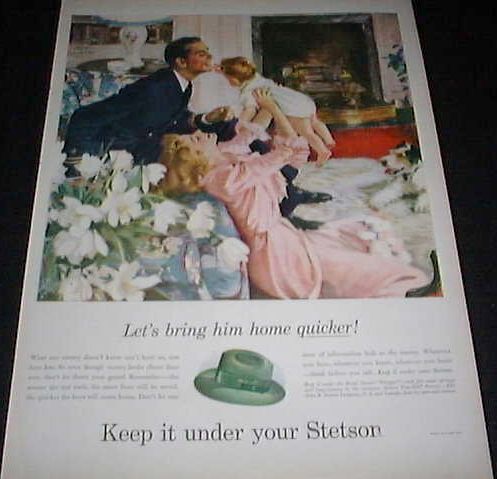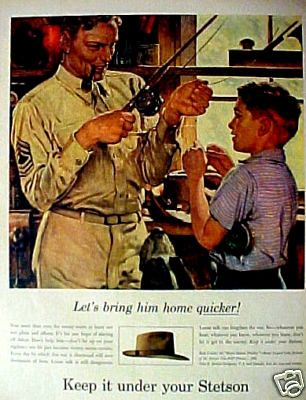I'm sure that just about all of us have seen at least a few of these ads. Today, I came across this article about the ads/posters, which also references an article that isn't available online (as far as I can tell), that was written by Debbie Henderson. I've contacted Debbie through her website and requested that she provide me with a paper or electronic copy of her article. If she does, and if she gives me her permission, I'll post a copy of it here.
It's interesting to note that the article says that there are 5 posters in the series, but I've got 9 different posters here. If you've got more of these, please post them in this thread.



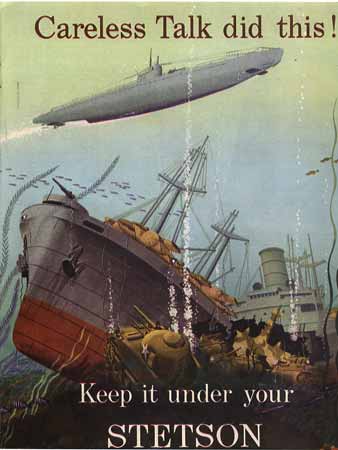
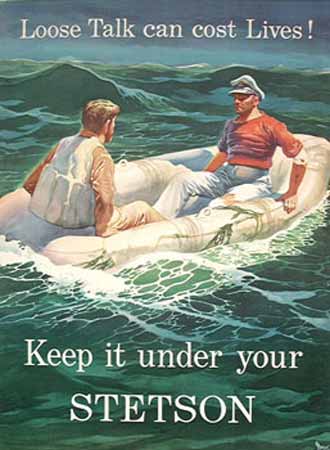

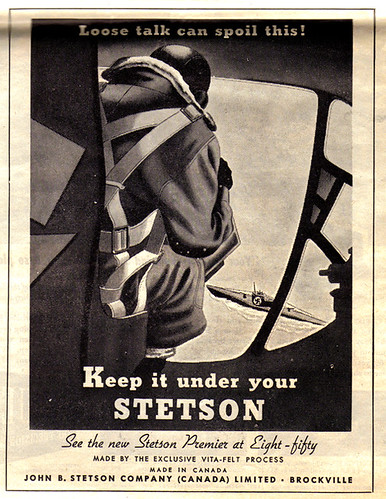


Keep it under your stetson--one firm's contribution to the war effort
Chronicle of the Early American Industries Association, Inc., The , Mar 2001 by Wyman, Thomas
Manufacturers of domestic products had a tough time in World War II keeping their names in front of the public. They turned to patriotic themes as one method of doing so.
I was reminded of this sometime ago after reading Debbie Henderson's most interesting article, "The Stetson Myth," (The Chronicle, December 1998, Vol. 51, No. 4). As an addition to her paper, readers might be interested to learn about a series of five advertising posters which Stetson produced during the war. Each poster measured approximately thirty inches by forty inches and each carried the same message, "Loose Talk can cost Lives! Keep it under your Stetson." Individually, the posters got the Stetson advertising message across, and together as a panel they conveyed a graphic picture of what "loose talk" could cost the nation and war effort. During the war years these posters were distributed to clothing stores and haberdasheries which carried the Stetson line. Shopkeepers would have had to use at least fifteen feet of open wall space to display the five posters effectively, which suggests that only a limited number of stores would have bad the room to display them.
Each poster has a different subject. There is a thin furtive man in a suit coat with his hat pulled down making a hushed call from a public telephone booth. One poster depicts a grim scene seen through the periscope of a Uboat-a cargo ship with its cargo handling booms has just been struck by a torpedo, and a violent explosion obscures the midsection of the vessel. Then there is the scene of two pathetic men in torn, ragged clothes in a small rubber life raft. It seems clear that they haven't much hope of being spotted and surviving. Finally there are the two posters shown here. Figure I shows an attractively coiffured woman with an earring featuring a swastika. Figure 2 shows a gleeful pilot wearing goggles and eyeing a convoy.
The provenance of this particular set of Stetson posters begins with my brother, who as a high school student during 19441945, worked in a Palo Alto clothing store. He was so enamored of the set that when it came time to take them down and dispose of them, he rolled them up and brought them home on his bicycle much to Mother's dismay. For years they hung casually on nails in our home-built workshop.
I kept an eye on the posters over the years, making sure they weren't lost or dammed by rain in their lessthan-waterproof environment. Then when it came time for me to level our deteriorating workshop, I rescued the posters and kept them out of harm's way. Finally, a few years ago, my brother and I decided to share the posters. We framed them and hung them in our respective homes where they have become real conversation pieces.
Perhaps this information will provide an interesting footnote to the Stetson legend, and to one company's efforts during the war.
Thomas Wyman
Thomas Wyman is the president of the Oughtred Society, the international group of slide rule collectors.
[How cool would it be to call yourself President of the slide rule collectors?]
It's interesting to note that the article says that there are 5 posters in the series, but I've got 9 different posters here. If you've got more of these, please post them in this thread.








Keep it under your stetson--one firm's contribution to the war effort
Chronicle of the Early American Industries Association, Inc., The , Mar 2001 by Wyman, Thomas
Manufacturers of domestic products had a tough time in World War II keeping their names in front of the public. They turned to patriotic themes as one method of doing so.
I was reminded of this sometime ago after reading Debbie Henderson's most interesting article, "The Stetson Myth," (The Chronicle, December 1998, Vol. 51, No. 4). As an addition to her paper, readers might be interested to learn about a series of five advertising posters which Stetson produced during the war. Each poster measured approximately thirty inches by forty inches and each carried the same message, "Loose Talk can cost Lives! Keep it under your Stetson." Individually, the posters got the Stetson advertising message across, and together as a panel they conveyed a graphic picture of what "loose talk" could cost the nation and war effort. During the war years these posters were distributed to clothing stores and haberdasheries which carried the Stetson line. Shopkeepers would have had to use at least fifteen feet of open wall space to display the five posters effectively, which suggests that only a limited number of stores would have bad the room to display them.
Each poster has a different subject. There is a thin furtive man in a suit coat with his hat pulled down making a hushed call from a public telephone booth. One poster depicts a grim scene seen through the periscope of a Uboat-a cargo ship with its cargo handling booms has just been struck by a torpedo, and a violent explosion obscures the midsection of the vessel. Then there is the scene of two pathetic men in torn, ragged clothes in a small rubber life raft. It seems clear that they haven't much hope of being spotted and surviving. Finally there are the two posters shown here. Figure I shows an attractively coiffured woman with an earring featuring a swastika. Figure 2 shows a gleeful pilot wearing goggles and eyeing a convoy.
The provenance of this particular set of Stetson posters begins with my brother, who as a high school student during 19441945, worked in a Palo Alto clothing store. He was so enamored of the set that when it came time to take them down and dispose of them, he rolled them up and brought them home on his bicycle much to Mother's dismay. For years they hung casually on nails in our home-built workshop.
I kept an eye on the posters over the years, making sure they weren't lost or dammed by rain in their lessthan-waterproof environment. Then when it came time for me to level our deteriorating workshop, I rescued the posters and kept them out of harm's way. Finally, a few years ago, my brother and I decided to share the posters. We framed them and hung them in our respective homes where they have become real conversation pieces.
Perhaps this information will provide an interesting footnote to the Stetson legend, and to one company's efforts during the war.
Thomas Wyman
Thomas Wyman is the president of the Oughtred Society, the international group of slide rule collectors.
[How cool would it be to call yourself President of the slide rule collectors?]




